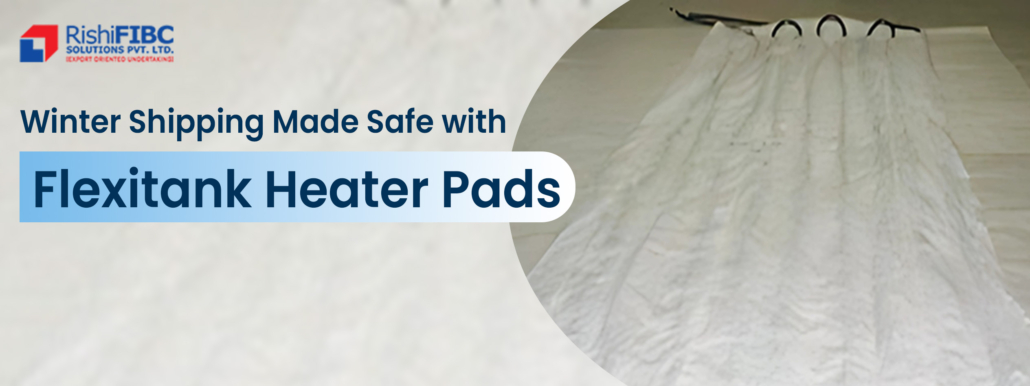In liquid bulk transport, flexitanks have revolutionized how companies ship large-volume liquids like edible oils, syrups, or chemical solutions in standard containers. However, winter weather introduces a risk: many of these products will freeze or become extremely viscous at low temperatures, making unloading difficult or impossible. Heater pads for flexitanks solve this problem by gently warming the cargo inside the tank. This flexitank heating pad is placed under the flexibags and provides consistent heat during transit, converting any frozen or semi-solid liquid back into a flowable state. By keeping the liquid at an optimal temperature, heater pads ensure smooth pumping and preserve product quality, so your bulk shipment arrives safely and on-spec.
Why a Flexitank Heating Pad Is Essential for Winter Shipments
Shipping liquids in winter poses specific challenges. Without heating, oils, fatty acids, syrups, and many chemicals can congeal or crystallize in a cold container, leading to clogged pumps and delayed unloading. Flexitank guides warn that “liquid products with high viscosity or high melting point… would consolidate or become viscous in a cold environment during transit, and become difficult to be discharged”. A flexitank heating pad prevents these problems by melting or thinning the cargo as needed. Key benefits include:
- Prevent freezing: Heater pads keep cargo above its solidification point, so oils and syrups don’t freeze into a block.
- Maintain fluidity: Even highly viscous products remain pumpable. As one industry source notes, heating pads lower the viscosity of cooled liquids to the levels needed for discharge.
- Preserve quality: By avoiding freeze-thaw cycles or crystallization, the product’s purity and consistency are protected. Consistent heat “ensures that your products remain at the optimal temperature… avoiding issues like solidification or changes in viscosity”.
- Cost and time savings: Warmed cargo unloads faster, eliminating downtime and extra labour. Heaters avoid the expense and complexity of refrigerated containers, offering a simpler, more cost-effective solution.
In short, adding a heater pad to each flexitank makes winter logistics reliable. Even a single flexitank heating pad can save thousands in potential losses by ensuring your liquid cargo stays fluid and on schedule.
Flexitank Heating Pad Applications in Food and Chemical Shipping
Heater pads are used across many industries that ship temperature-sensitive liquids:
- Food and beverage: Bulk edible oils (palm oil, coconut oil), sugar syrups, corn syrup, and fruit concentrates all benefit. For instance, sugar syrup and coconut oil in a flexitank rely on heat to prevent solidification. Frozen or thick product would be difficult to pump out without a heater.
- Chemical products: Glycols, glycerine, polyols, fatty acids, and high-viscosity solvents can gel in the cold. Heating pads ensure these liquids flow normally. Even non-hazardous chemical intermediates are shipped safely when the temperature is controlled.
- Food additives & distillates: Items like distilled fatty acids and oils require consistent warmth. The pad’s gentle heat keeps these substances homogeneous.
- Other bulk liquids: Any liquid bulk transport involving oils, fats, syrups, or viscous chemicals will see benefits. Reliable heat control prevents quality degradation, meeting safety and regulatory standards.
In each case, using a flexitank heating pad keeps products in spec. By heating from the bottom of the bag, the pad thaws any solid edges and maintains uniform viscosity throughout unloading.
Fluid Flexitank’s Winter Shipping Solutions
Selecting the right heater pad is crucial. Fluid Flexitank offers specialized solutions for cold-weather shipping. Our Heater Pads For Flexitanks are engineered to fit standard 20-ft container flexibags and connect easily to steam or electric heat sources. Made from high-temperature-resistant materials, these pads deliver even heating without damaging the flexitank. Fluid Flexitank’s experts guide customers through the process: choosing a pad based on cargo type, melting point, and container size. In fact, industry leaders note that “consulting with an experienced supplier like Fluid Flexitank can help you determine the best solution” for each shipment.
Importantly, heater pads are far more cost-effective than reefer containers. They offer consistent temperature control at a fraction of the operational cost. Installation is quick and straightforward, with plug-and-play temperature controls. This simplicity means no special training is needed, and the pads are reusable trip after trip. By maintaining the proper cargo temperature, Fluid Flexitank’s heater pads protect product integrity and compliance. “By maintaining the correct temperature, you minimize the risk of damage or contamination,” keeping your reputation strong.
Conclusion
In practice, top-quality flexitanks from Fluid Flexitank (made with FDA-approved materials for food-grade cargo) pair perfectly with our heater pads. Together they create a robust winter shipping system. For example, using our heater pad under a palm oil flexitank will prevent waxing and ensure the oil arrives liquid and pumpable.
FAQs:
- Q: Why are flexitank heater pads essential in winter?
A: Flexitank heater pads keep liquids from freezing or becoming too thick. They maintain the proper temperature in transit, ensuring smooth pumping and preserving the quality of your bulk liquid cargo. - Q: How do heater pads prevent liquids from freezing?
A: Heater pads, placed under the flexitank, provide steady heat that slowly melts or warms the cargo. This converts viscous or semi-solid liquids evenly back into a flowable state before unloading. - Q: What products benefit from flexitank heater pads?
A: Bulk liquids like edible oils (palm, coconut), sugar syrups, glycerine, and fatty acids benefit from heater pads. These pads keep such products fluid and pumpable, preventing solidification in cold conditions. - Q: Are heater pads cost-effective compared to refrigeration?
A: Heater pads are a cost-effective alternative to full refrigeration in winter. They keep cargo at target temperature, reduce energy use and spoilage risk, and are easy to install and use.

